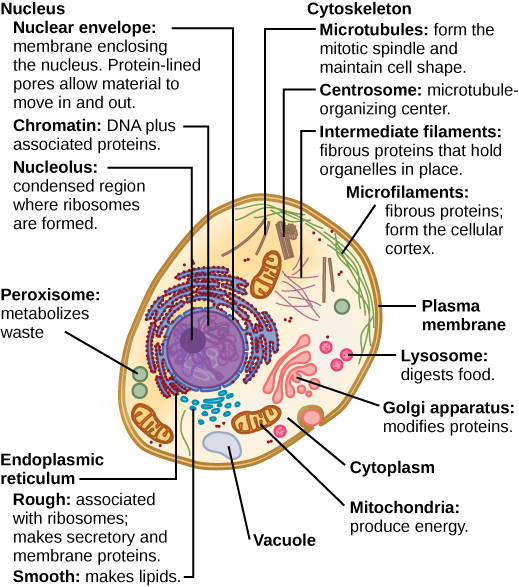Which Structure Is Common To Plant And Animal Cells? Biology Quizlet
4.six: Eukaryotic Cells - Characteristics of Eukaryotic Cells
- Page ID
- 12715
- Describe the structure of eukaryotic cells
Eukaryotic Cell Structure
Like a prokaryotic cell, a eukaryotic jail cell has a plasma membrane, cytoplasm, and ribosomes. However, unlike prokaryotic cells, eukaryotic cells have:
- a membrane-bound nucleus
- numerous membrane-bound organelles (including the endoplasmic reticulum, Golgi apparatus, chloroplasts, and mitochondria)
- several rod-shaped chromosomes
Because a eukaryotic cell'southward nucleus is surrounded by a membrane, it is often said to accept a "true nucleus. " Organelles (meaning "piddling organ") have specialized cellular roles, simply as the organs of your body have specialized roles. They allow unlike functions to exist compartmentalized in different areas of the jail cell.
The Nucleus & Its Structures
Typically, the nucleus is the almost prominent organelle in a cell. Eukaryotic cells take a true nucleus, which means the cell'south DNA is surrounded by a membrane. Therefore, the nucleus houses the prison cell'southward Dna and directs the synthesis of proteins and ribosomes, the cellular organelles responsible for protein synthesis. The nuclear envelope is a double-membrane construction that constitutes the outermost portion of the nucleus. Both the inner and outer membranes of the nuclear envelope are phospholipid bilayers. The nuclear envelope is punctuated with pores that control the passage of ions, molecules, and RNA between the nucleoplasm and cytoplasm. The nucleoplasm is the semi-solid fluid within the nucleus where nosotros find the chromatin and the nucleolus. Furthermore, chromosomes are structures within the nucleus that are fabricated up of Dna, the genetic material. In prokaryotes, DNA is organized into a single circular chromosome. In eukaryotes, chromosomes are linear structures.

Other Membrane-Bound Organelles
Mitochondria are oval-shaped, double membrane organelles that accept their own ribosomes and DNA. These organelles are often chosen the "energy factories" of a cell because they are responsible for making adenosine triphosphate (ATP), the cell's main energy-carrying molecule, by conducting cellular respiration. The endoplasmic reticulum modifies proteins and synthesizes lipids, while the golgi appliance is where the sorting, tagging, packaging, and distribution of lipids and proteins takes place. Peroxisomes are small, round organelles enclosed past single membranes; they acquit out oxidation reactions that suspension downward fatty acids and amino acids. Peroxisomes besides detoxify many poisons that may enter the body. Vesicles and vacuoles are membrane-spring sacs that office in storage and transport. Other than the fact that vacuoles are somewhat larger than vesicles, there is a very subtle distinction between them: the membranes of vesicles can fuse with either the plasma membrane or other membrane systems within the cell. All of these organelles are found in each and every eukaryotic prison cell.
Animal Cells Versus Constitute Cells
While all eukaryotic cells incorporate the aforementioned organelles and structures, at that place are some striking differences betwixt animal and found cells. Animal cells accept a centrosome and lysosomes, whereas plant cells do not. The centrosome is a microtubule-organizing center found near the nuclei of animal cells while lysosomes take care of the cell's digestive process.

In addition, plant cells have a cell wall, a large central vacuole, chloroplasts, and other specialized plastids, whereas fauna cells practice not. The jail cell wall protects the cell, provides structural back up, and gives shape to the jail cell while the central vacuole plays a cardinal role in regulating the cell's concentration of water in changing environmental conditions. Chloroplasts are the organelles that carry out photosynthesis.

Key Points
- Eukaryotic cells are larger than prokaryotic cells and accept a "true" nucleus, membrane-bound organelles, and rod-shaped chromosomes.
- The nucleus houses the jail cell'due south DNA and directs the synthesis of proteins and ribosomes.
- Mitochondria are responsible for ATP product; the endoplasmic reticulum modifies proteins and synthesizes lipids; and the golgi apparatus is where the sorting of lipids and proteins takes place.
- Peroxisomes carry out oxidation reactions that interruption down fatty acids and amino acids and detoxify poisons; vesicles and vacuoles part in storage and send.
- Animate being cells have a centrosome and lysosomes while plant cells exercise not.
- Plant cells have a cell wall, a big key vacuole, chloroplasts, and other specialized plastids, whereas beast cells do non.
Key Terms
- eukaryotic: Having circuitous cells in which the genetic material is organized into membrane-bound nuclei.
- organelle: A specialized construction found inside cells that carries out a specific life process (e.g. ribosomes, vacuoles).
- photosynthesis: the process by which plants and other photoautotrophs generate carbohydrates and oxygen from carbon dioxide, h2o, and calorie-free energy in chloroplasts
Source: https://bio.libretexts.org/Bookshelves/Introductory_and_General_Biology/Book%3A_General_Biology_(Boundless)/04%3A_Cell_Structure/4.06%3A_Eukaryotic_Cells_-_Characteristics_of_Eukaryotic_Cells
Posted by: grandepoved1950.blogspot.com

0 Response to "Which Structure Is Common To Plant And Animal Cells? Biology Quizlet"
Post a Comment